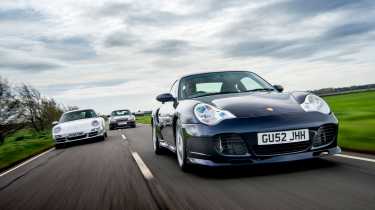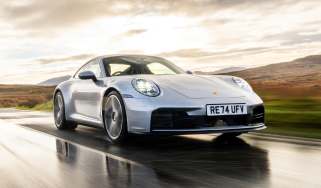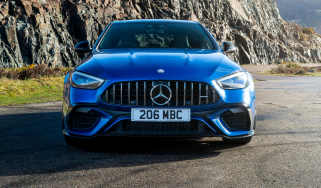The Porsche 911s you can afford
We look at three 911s ranging from £13,000 to £35,000 that won't break the bank
Amongst car enthusiasts, I reckon there are three main groups when it comes to the Porsche 911: those who have always wanted a 911; those who pretend they hate 911s but secretly really want one anyway; and those who are blissfully unaware of what they are missing out on, but who often – although not always – succumb when they try one. This rear-engined institution of complex contradictions may not be for everyone, but there aren’t many who can avoid falling under its spell at some point.
The trouble is, the words ‘value’ and ‘Porsche’ have become increasingly distanced of late, as you may have noticed. No marque has benefited more – or suffered, depending on your viewpoint – from the classic car boom. Aren’t old Porsches all about investment values and classic car shows now?
All those rusty 911 SCs, once £10,000, now positioned as brilliant classics by specialist vendors determined to give you a history lesson of the type at the start of their ads before you get to the nitty gritty about the car itself. Those 964s, those same 964s that leaked oil like the Exxon Valdez and were received with lukewarm indifference by the press at launch, no longer sub-£15,000 cars but fifty thou’ and rising. And let’s not even mention the GT3 market; it’s too depressing if you’re of meagre means. Cars designed and built for track work, now often too valuable to risk on the track.
> Read our review of the current Porsche 911
Yet here’s the thing: the ten-grand 911 is alive and well (see below), and for a little more there’s a plethora of choices – as long as you’re prepared to go water-cooled. Twenty years on from the first 911 Carrera to feature a radiator, these are now terrific evo cars to be had at realistic prices. So if a new 991.2 GT3 RS has whetted your appetite, but your bank account is firmly anchored in the real world, then read on.
Where to start with the 996 Carrera? One half of the double-act that saved Porsche the company; a complete re-imagination – bar the rear suspension – of the then 35-year-old 911, yet still unmistakably a 911 to the very core. A smooth, deceptively complex collection of radii and form that aged rapidly until it became ’90s passé, yet now looks as pure as a Highland spring. A car, let’s face it, with a reputation for, er, blowing its engine to pieces.
Do your homework and you’ll come to realise that the 996 isn’t the most susceptible of the water-cooled 911s for engine issues, although they all began with this car. They range from relatively harmless oil leaks – the RMS issue (rear main seal) – to the potentially much more debilitating IMS problem, where the bearing on the intermediate shaft (taking drive from the crank to the cams) fails, depositing swarf into the engine, with terminal results.
It’s more likely to happen on later 996s, and there are ways and means to prevent it. Finally, and most troublingly, there are the issues with the bores themselves on the M96 engine. A few early cars experienced cracked blocks, but the real issue is scoring and ovalling of the liners. There are a million theories why this might happen, with no definitive answer, but a combination of Lokasil liners and a cooling circuit that should never be compromised have a lot to do with it. Treating the engine kindly from cold and making sure it never overheats is a good place to start, and there’s an old adage that says if it hasn’t failed by now, then it’s unlikely to do so.
The trouble for the 996 – and the 997 for that matter – is that its engine frailties have come, in many ways, to define it – certainly on the internet. That’s understandable in a way, because it’s a Porsche and expectations are always sky high, but most high-value/high-performance cars have engine or major component weaknesses at higher mileages that can be hideously expensive. Moreover, few in-period rivals will have amassed the same level of mileage as the average 911. So you need to take a view: be scared off by the screaming headlines, or do some homework and then buy one of the very best cars evo has ever tested?
Given you’ll no doubt gravitate towards a coupe, not a convertible, and a manual gearbox is a must, not the slushy old Tiptronic, then it is only just still possible to buy a car like Henry Powell’s R-plate 996 you see here for around £13,000, and probably for not much longer. This isn’t any old 996 either – it’s a piece of history. One of only 14 996s brought into the UK late in 1997, before any cars had reached customers, it is a true survivor.
The wonderful thing about the 996 is its Germanic pragmatism. It predates the era of Lane Change Assist and programmed-in exhaust burbles on the overrun. It’s gimmick-free, light (1320kg), compact, and almost entirely focused on driving pleasure. While the type grew physically over the 993, it retains the shallow dashboard, relatively upright windscreen and narrow width that are such a part of the 911 – and are diluted in the 991 – yet still feels like a modern car with all the usability and refinement that entails.
To be fair, it has tested Henry’s patience. Not long after he bought it the very worst happened with the engine (although not, oddly, one of the usual issues), and it’s been a complicated and expensive road to get where he is today. But then I glance in the rear-view mirror of the car I’m driving, and clock the broad grin on Henry’s face as he uses a healthy dose of revs to stick on my tail, and I know he feels that every penny was worth the recovery price.
Driving it, I can see why. The 3.4-litre engine is revvy and potent (300bhp). Every control has that polish and uniformity of weight that’s the hallmark of a Porsche, and you soon find yourself picking cornering lines with the fingertips and savouring every gearchange. And that hydraulic steering… oh man. When you drive a car like the 996 you realise that Porsche’s current electrically assisted systems, however good they are for their kind, simply don’t impart the same sense of connection with the road’s surface.
So, it’s a great 911: purrs and yelps where a similarly powerful 718 Cayman sounds like a fairground generator, offers that ever-useful 2+2 seating and reasonable luggage space, yet manages to feel like a proper sports car. It’s unlikely to be hot-hatch cheap to run, but it is at least rising in value, not depreciating, and it doesn’t feel like a lot of money to acquire a definite modern classic.
Double our cash and we’re in 997 territory, and you’ll no doubt be drawn to the delectable shape of the Carrera S, with its meaty, 350bhp 3.8-litre motor (a close relation of the M96 known as an M97), bigger wheels and quad exhausts. These first-generation 997 Ss are perhaps the most likely to suffer bore issues of all the Porsches in this era, possibly because there’s simply less metal in and around the engine with the bigger bore size.
But beyond its potential to bring financial hardships, the Gen 1 997 has so much going for it. For many, the return to a more traditional exterior style was just what the 911 needed, and the car still looks glamorous today to my eyes. The interior is more conventional but obviously more ‘premium’, though it wears no better than a 996’s, if even at that. For taller drivers the ergonomics are improved, too, with the seat dropping lower, more adjustment on the wheel, and the pedals further away. It may be largely the same as its 996 predecessor under the skin, but the 997 is such a thorough evolution that it feels like a different car. Those die-hard 911 fans still had something to moan about, though: back in 2004, the 997’s switch to a variable-ratio rack was a major topic for forum debate, just as every new generation of 911 upsets the faithful somehow. It’s a heavier car than the 996, too, by 100kg.
This particular example, an early S in the default silver exterior/black leather interior combination, was sourced from Porsche specialist RPM Technik. It’s a car RPM bought just prior to our photoshoot, on behalf of a customer as a donor vehicle for one of its CSR conversions. As such, it’s by no means ‘retail’ quality, but rather is an interesting window on to what you might find if you buy a ‘cheap’ 997 S privately. Having given it a safety inspection prior to our collection, RPM reckoned wear to the suspension and brakes was significant – the CSR conversion will replace all those bits anyway – and you can feel that from the moment you’re under way. The magic that means the 997 usually breezed a group test back in the day is still there, but it’s hidden under a veil of lazy damping, imprecision from worn bushes and general tiredness. At 13 years and 120,000 miles old this 997 needs a thorough renovation if the magic is to return, which is very expensive if you do it all in one go.
That’s the reality, but look past the negatives and I still think it’s hard to find a car that rewards on so many levels like a 997. It’s just so… right. From the way it looks to the way it sounds – all sonorous, chesty, then wailing at higher rpm – to the way it drives, the driving position… Heck, everything! I simply adore it. For the same money as a new Peugeot 208 GTi it is indescribably tempting, even if the purchase price won’t be the last cost.
The later Gen 2 997s are holding up well in terms of value. They use the completely different MA1 engine also found in the back of the Gen 1 991, which doesn’t suffer from the same issues as the M97. However, they’re also much more rare and considerably more expensive. And if you do have that budget – let’s say £35,000 upwards – then for similar money we can head back in time again to the mighty 996 Turbo, which is where things get really serious.
The 996 Turbo is one of the classic supercars. There have been louder, flashier, bigger 911 Turbos since, but it only takes a mile at the wheel of this lovely example borrowed from Harrington Finance to feel the magic that made it such a critical and commercial success at the turn of the millennium. Sadly, the days of the twenty-five grand Turbo have long gone. You’ll need £35,000 upwards for a higher-mileage manual Turbo (don’t even think about a Tiptronic – it blunts the car’s performance USP), and around ten grand more for a nice car with under 60,000 miles. Go for the run-out Turbo S, with its 450bhp ‘X50’ power upgrade featuring bigger turbos for the 3.6-litre motor, and ceramic brakes, and you’ll be looking at over £60,000 for the very best.
The cornerstone of the Turbo’s appeal is ‘The Mezger’. Named after famed Porsche engineer Hans Mezger, it is one of the great internal combustion engines, with its roots in Porsche’s racing units of the 1970s, and more recently, the 911 GT1. Designed for use in the 996 GT3, but adopted and adapted for the Turbo (where it was coded, confusingly, M96.70), it brought economies of scale and enabled production of both models, right the way through to the 997.2 GT3 RS 4.0 and the 997.1 Turbo. Like the RB26 in the Nissan Skyline GT-R, the Mezger’s racing roots mean that it’s as hard as nails and capable of being substantially tuned: with uprated turbos you can get over 600bhp before you need to open the engine up for strengthening.
While there’s more lag than you get with a modern Turbo, there’s an awful lot less than with an original 1970s/’80s 930. Connected to a manual gearbox, the more traditional boosted delivery of the 996 Turbo actually makes it more exciting than its modern equivalent, more of a driving challenge. In fact, it’s perfectly possible to drive around without waking the turbochargers at all, and still keep up with traffic. (Another reason to seek out a car with the manual gearbox.) There’s a delectable kind of serenity from driving around thus, finessing the weighty but rewarding ’box and clutch, savouring all that feedback from the steering wheel, but knowing at any moment a squeeze of throttle will catapult you past slower traffic. And yes, the Turbo still feels massively fast, even with the standard 414bhp this car has. You see a gap, open the taps, and whoosh, there’s that weightless feeling that’s so addictive.
Naturally, the four-wheel-drive, wide-arched Turbo is heavier than the little rear-drive Carrera bobbing along behind (by 220kg). It’s a more serious, measured sort of driving experience, but with narrower rubber than a modern Turbo, it manages to combine immense security and traction with a lower ultimate threshold of grip, so when it does start to oversteer – which it will – it happens in a more progressive, manageable way. It’s not a car that feels ‘four‑wheel drive’.
The Turbo was a car designed and built for the well-heeled who demanded that ultimate GT performance car from Porsche: a car equally capable of lapping the Ring, blasting across Europe for hours on end in terrible weather, or commuting into the city. That’s all yours for the same price as a new BMW 420i M Sport. Sure, the ‘Turbo tax’ on parts and the fact that it’s a 15-year-old supercar mean it’s still expensive to run – the intercoolers and pipework need looking after, and as with the Carreras, healthy bushes and dampers are key to a Turbo driving as you’d hope – but at least you don’t have to worry anything like as much about its engine.
So there you have it. The classic 911 ship has not sailed without you. It’s simply available now with antifreeze.
With thanks to Henry Powell, RPM Technik, and Alex Read at Harrington Finance.









